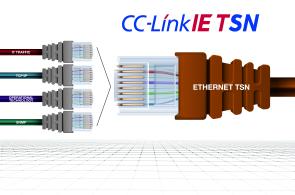Advancing network management with SNMP
Applying SNMP to the OT level is now a reality – here’s why
Engineers can gain a unique insight into the health and performance of their networks and devices thanks to Simple Network Management Protocol (SNMP). Its use is key to advance industrial automation and Industrial Internet of Things (IIoT) applications, and it is now closer to becoming a reality, thanks to one future-oriented network technology.
John Browett, General Manager at the CC-Link Partner Association (CLPA), looks at SNMP, its benefits as well as how, when combined with the right network, it can support industrial automation and control applications.
SNMP has been widely used throughout all information technology (IT) domains since its foundation, in the 1980s. It sits on the application layer of the Open Systems Interconnection (OSI) model to support the management and monitoring of devices connected over Internet Protocol (IP) networks. These include Ethernet switches, as well as any device that supports IP or Transmission Control Protocol (TCP) communication, such as bridges, routers, access servers, computer hosts, hubs, printers and cameras. In effect, all these devices come with bundled SNMP agents.
The technology is used extensively as it collects key data that can help IT professionals be aware of the status of all their managed devices and applications. In effect, every network component can be queried in real time to look at their performance metrics through management information base (MIB) files.
Also, if thresholds for certain values are exceeded, system administrators can be promptly alerted, supporting quick troubleshooting and advanced productivity. Due to the recent advances in SNMP cybersecurity, the solution can also be used to streamline the configuration and modification of devices within a network.
Applying the benefits of SNMP to OT
While the IT world has been leveraging SNMP for decades, the operational technology (OT) domain has been lagging behind in the adoption of this solution, despite its capabilities and the opportunities it presents. As IIoT applications become increasingly crucial to drive a business’ competitiveness, the paradigm must shift.
In effect, future-oriented communications need to rely on converged architectures, where IT and OT data are transferred by the same infrastructure.
By being able to apply the SNMP protocol to converged networks, companies can therefore continue to benefit from advanced management capabilities and rapid diagnostics for IT systems as well as provide these to OT communications too. This means that the ideal network should be able to support the protocol.
More and more automation devices are beginning to offer SNMP ports, however industrial communications solutions for the shop floor typically do not offer this function. The main reason behind this is the historic potential for disruption of security, stability and determinism on these networks, the avoidance of which is paramount.
The latest advances in the field are able to resolve these issues. Firstly, the newest SNMPv3 introduces key elements that address the vulnerabilities of previous versions, e.g. by means of an enhanced security system that authenticates messages and ensures their privacy. Simultaneously, Time-Sensitive Networking (TSN) is improving standard industrial Ethernet by enabling the transfer of multiple types of data traffic on one single cable while maintaining deterministic performance for time-critical OT communications.
Driving convergence and network management
Therefore, there are tools at hand that can be used to create converged, SNMP supported communications. As a network technology developed to enable the creation of forward-looking IIoT frameworks, CC-Link IE TSN is designed to offer convergence and SNMP functions.
In effect, this innovative solution is the first open industrial Ethernet to feature gigabit bandwidth and TSN functions, driving the setup of data-driven, interconnected factories. In addition, the compatibility with SNMP empowers users to collect device status information on industrial automation products, as well as other nodes. As a result, it is possible to improve network diagnostic capabilities, reducing system start-up times as well as the amount of time and effort spent on system administration and maintenance.
By selecting CC-Link IE TSN and its continuously expanding range of certified products, companies can get the most out of enabling network technologies. This, in turn, helps them bring their communications to the next level, driving up their productivity and competitiveness now and in the future.
About The CC-Link Partner Association (CLPA)
The CLPA is an international organization founded in 2000, now celebrating its 20th Anniversary. Over the last 20 years, the CLPA has been dedicated to the technical development and promotion of the CC-Link open industrial network family. The CLPA's key technology is CC-Link IE TSN, the world's first open industrial Ethernet to combine gigabit bandwidth with Time-Sensitive Networking (TSN), making it the leading solution for Industry 4.0 applications. Currently the CLPA has over 4,100 corporate members worldwide, and more than 2,000 compatible products available from over 370 manufacturers. Around 38 million devices using CLPA technology are in use worldwide.
Further Information:
Website: eu.cc-link.org
LinkedIn: https://www.linkedin.com/company/cc-link-partner-association-europe/
Twitter: twitter.com/cc_linknews
YouTube: youtube.com/user/CLPAEurope
Press contact:
CC-Link Partner Association Europe
John Browett
General Manager
Tel.: +44 (0) 7768 338708
john.browett@eu.cc-link.org
PR agency:
DMA Europa
Anne-Marie Howe
Progress House, Great Western Avenue, Worcester, WR5 1AQ, UK
Tel.: +44 (0) 1905 917477
anne-marie@dmaeuropa.com
https://news.dmaeuropa.com

The use of SNMP is key to advance industrial automation and Industrial Internet of Things (IIoT) applications, and it is now closer to becoming a reality, thanks to one future-oriented network technology.
- CC-Link Partner Association (CLPA)
Members Site 







